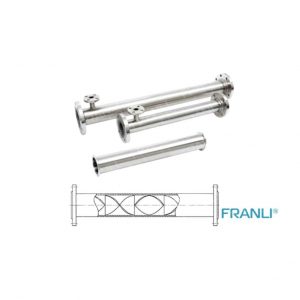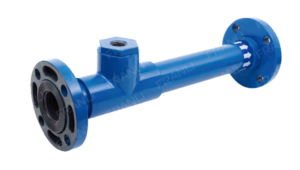Home » Inline Static Mixer: Application Range in Various Industries
Inline Static Mixer: Application Range in Various Industries
Inline Static Mixer
Application: Its application industries include chemical, petroleum, pharmaceutical, pesticide, food, plastic, daily chemicals, mining and metallurgy, papermaking, chemical fiber, cable, biology, environmental protection, etc.
The length of the pipe and the number and shape of the baffles depend on the application, flow rate, viscosity, and the desired degree of mixing. The Inline Static Mixer finds its application in numerous processes in many industries because of its simplicity, low cost, and effectiveness.
Water Treatment
The water treatment process involves mixing chemicals with water to remove impurities, such as suspended solids, bacteria, and dissolved minerals. The Inline Static Mixer is used to mix the chemicals with water to achieve a uniform concentration and reaction. The baffles inside the mixer create turbulence that enhances the mixing process and reduces the chemical dosing and reaction time. The Inline Static Mixer is also used to mix two or more chemicals before they are added to the water. The Inline Static Mixer can reduce the footprint of the mixing process, energy consumption, and chemical waste generation.
Chemical Processing
The chemical processing industry involves mixing different chemicals to form a new substance or to enhance the properties of an existing substance. The Inline Static Mixer is used to mix chemicals that are in liquid or gas form. The mixer can mix chemicals with different viscosities, densities, and mass flow rates. The Inline Static Mixer is also used in the production of emulsions, suspensions, and gel-like substances. The mixer can also be used to dilute concentrated chemicals before they are added to a process stream.
Food Processing
The food processing industry involves mixing different ingredients, such as liquids, powders, and solids, to make food products, such as sauces, soups, and dressings. The Inline Static Mixer is used to mix ingredients that are in liquid form. The mixer creates a uniform mixture, reduces the mixing time, and prevents lumps from forming. The mixer can also be used to homogenize milk, cream, and other dairy products, and to disperse and dissolve powders, such as sugar and salt.
Pharmaceuticals
The pharmaceutical industry involves mixing different chemicals to form a medicine or a drug. The Inline Static Mixer is used to mix chemicals that are in liquid or gas form. The mixer can also be used to mix viscous solutions, suspensions, and emulsions. The mixer can reduce the mixing time, increase the yield, and ensure a consistent quality of the product. The mixer can also be used to clean the pipelines and vessels in the pharmaceutical process.
Oil and Gas
The oil and gas industry involves mixing different chemicals, such as oil, gas, and water, to enhance recovery and process efficiency. The Inline Static Mixer is used to mix chemicals that are in liquid or gas form, such as surfactants, catalysts, and demulsifiers. The mixer can be used to enhance the performance of the separation processes and reduce the formation of emulsions and foams. The mixer can also be used in the desalination of seawater and the treatment of produced water.
Waste management
The waste management industry involves mixing and treating different types of waste, such as sewage, industrial effluent, and hazardous waste. The Inline Static Mixer is used to mix chemicals, such as coagulants and flocculants, with the waste to form a dense sludge that can be easily separated and dewatered. The mixer can also be used to mix air or oxygen with the waste to promote aerobic digestion and reduce odor emissions. The mixer can also be used in the treatment of biogas and other waste gases.
The Inline Static Mixer is a versatile and effective device that finds its application in many industries and processes. The mixer can be used to mix liquids and gases of different viscosities, densities, and flow rates, and can enhance the mixing efficiency and reduce the mixing time. The mixer can also reduce the footprint, energy consumption, and chemical waste generation in many processes. The above-discussed applications of the Inline Static Mixer are just a few examples of its versatility. The potential for its application in other processes is endless, and its importance in the industry is increasing day by day.
Welcome to send inquiry to us and let’s make a win win business together !
Guidelines For Static Mixer
Static mixer is a new type of online, high-efficiency mixing equipment in the process. A static mixer is a high-efficiency mixing device without moving parts. Its basic working mechanism is to use the mixing unit fixed in the tube to change the flow state of the fluid in the tube, so as to achieve good dispersion and full mixing of different fluids.

Inline Static Mixers: A Comprehensive Product Overview
Inline static mixers are the best devices that provide efficient and cost-effective mixing solutions for various industrial applications. These motionless mixers are designed to blend fluids within a pipeline without the need for moving parts or external power sources.

Inline Static Mixer: Application Range in Various Industries
The Inline Static Mixer is a device that mixes two or more streams of fluids or gases inside a pipeline without any moving parts. The device is usually a long pipe with carefully placed baffles that create turbulence to mix the fluids.

Application of Static Mixer Tubes in various industries
A Static Mixer Tube is an essential component in the process industry, with applications ranging from chemical processing to wastewater treatment.

Static Mixer: The Solution for Efficient Mixing
A static mixer is a device that uses stationary blades or elements to mix fluids or gases. Unlike traditional mixers, static mixers do not have moving parts, such as agitators or impellers. Instead, they rely on the geometry and placement of the mixing elements to create turbulence and promote mixing. Static mixers come in various shapes and sizes, depending on the application and flow rate.

